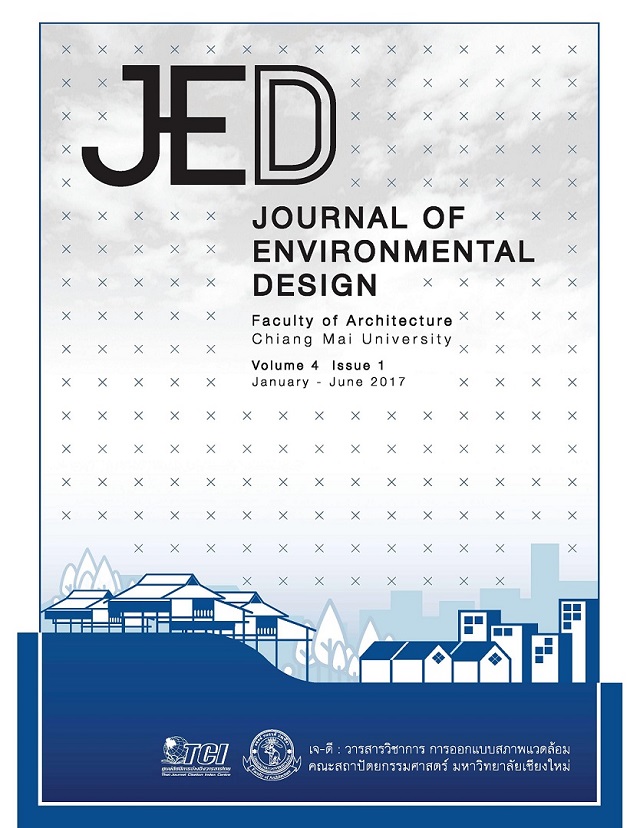การศึกษาแนวคิดเพอการออกแบบพทธอุทยานรัตนมหาเจดีย์ ในศรีลังกา อินเดีย และจีน (The study of the conceptual design for Rattana Maha Chetiya Buddha Park in Srilanka, India and China)
Main Article Content
บทคัดย่อ
การศึกษาแนวคิดเพื่อการออกแบบพุทธอุทยานรัตนมหาเจดีย์ประเทศศรีลังกา อินเดีย และจีน
มีวัตถุประสงค์เพื่อเชื่อมโยงวิถีชีวิตแบบอริยชน (สัปปายะสถาน) โดยใช้หลักธรรมเป็นตัวกลางในการออกแบบสถาปัตยกรรม โดยเปรียบเทียบกับพุทธอุทยานรัตนมหาเจดีย์ในศรีลังกา อินเดีย และจีน ผลการศึกษาพบว่า รูปแบบสถาปัตยกรรม เสา ผนัง หลังคา พื้น ถูกกำหนดขึ้นเป็นจุดเปรียบดังจุลจักรวาลของจิต อันสุขสว่างที่มั่นคง เบิกบาน สงบเย็นเป็นตัวนำ เป็นตัวหลักชัย (หลักของใจหรือเจติยะ) ส่วนที่ว่างและช่องเปิด เป็นปรากฏการณ์และท่วงทำนองแห่งแสง เป็นปราณพลังแห่งชีวิต แห่งกาลเวลาที่แปรเปลี่ยนสัมพันธ์กับบริบทโดยรอบ ส่วนเสาของห้องเป็นที่ประดิษฐานพระบรมสารีริกธาตุแสดงให้เห็นถึงนิมิตหมายของปัญญาแห่งธรรม มีลานเป็นฌานแห่งธรรมแหล่งที่ตั้งแห่งจิตคือสมาธิ โดยใช้หลักการแห่งพุทธะ ศีล สมาธิ ปัญญา หลักการพัฒนาจิตที่เป็นระบบมากที่สุด เป็นวิถีแห่งธรรมของกิจกรรมในชีวิตประจำวัน ในงานศาสตร์แห่งสถาปัตยกรรม มีธรรมชาติแวดล้อมสังคมเป็นศีลวัตร มีธรรมมงคลเป็นมณฑลแห่งชีวิตที่เกื้อกูลกับธรรมชีวิตสัมพันธ์กับสภาพแวดล้อมมากยิ่งขึ้นไป มีความวิจิตรประณีตบรรจง ละเมียด งดงาม และสงบเย็นอย่างไร้ตัวตนในที่สุด
The purpose of the study of the conceptual design for Rattana Maha Chetiya Buddha Park Design in Srilanka, India and China is to link simple places with dharmic principle that is used in designing Architecture. The study focuses on Rattana Maha Cetiya Buddha Park Design in Srilanka, India and China. The result shows that the form of the architecture including the pillar, the wall, the roof, and the floor are made to represent a holon of the mind, which is bright, stable, cheerful, and peaceful. They also represent the leader and the main (the main of the heart). For the empty space or the hole, it is a phenomenon and the way of light, which is the power of life and time that always change according to the context. The pillar of the room where the Rattana Maha Chetiya Buddha is placed represents propitious wisdom. Having the courtyard to represent dharmic contemplation and the home of spirit (concentration), it uses the dharmic principle: virtue, concentration, and wisdom. It is a way to systematically develop the mind and dharmic way for daily activities. In architecture, the environment is the precepts, the doctrine is the life domain. It is the place that supports the dharmic of life, which relates to the environment. It is exquisite, delicately, gentle, artistic, and peaceful.


